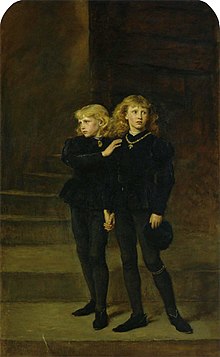User talk:The Kiddle Plague

The Princes in the Tower refers to the apparent murder in England in the 1480s of the deposed King Edward V of England and Richard of Shrewsbury, Duke of York. These two brothers were the only sons of King Edward IV and Elizabeth Woodville surviving at the time of their father's death in 1483. When they were 12 and 9 years old, respectively, they were lodged in the Tower of London by their paternal uncle and all-powerful regent the Duke of Gloucester. This was supposedly in preparation for Edward V's forthcoming coronation. However, before the young king could be crowned, he and his brother were declared illegitimate. Gloucester ascended the throne as Richard III.[1]
It is unclear what happened to the boys after the last recorded sighting of them in the tower. It is generally assumed that they were murdered; a common hypothesis is that they were killed by Richard in an attempt to secure his hold on the throne. Their deaths may have occurred sometime in 1483, but apart from their disappearance, the only evidence is circumstantial. As a result, several other hypotheses about their fates have been proposed, including the suggestion that they were murdered by their maternal uncle the Duke of Buckingham or future brother-in-law King Henry VII, among others. It has also been suggested that one or both princes may have escaped assassination. In 1487, Lambert Simnel initially claimed to be the Duke of York, but later claimed to be York's cousin the Earl of Warwick. From 1491 until his capture in 1497, Perkin Warbeck claimed to be the Duke of York, having supposedly escaped to Flanders. Warbeck's claim was supported by some contemporaries, including York's aunt the Duchess of Burgundy.
In 1674, workmen at the tower dug up, from under the staircase, a wooden box containing two small human skeletons. The bones were widely accepted at the time as those of the princes, but this has not been proven and is far from certain. King Charles II had the bones buried in Westminster Abbey, where they remain.
Speedy deletion nomination of User:The Kiddle Plague
[edit]
Hello, and welcome to Wikipedia. A tag has been placed on User:The Kiddle Plague requesting that it be speedily deleted from Wikipedia. This has been done under section U5 of the criteria for speedy deletion, because the page appears to consist of writings, information, discussions, and/or activities not closely related to Wikipedia's goals. Please note that Wikipedia is not a free web hosting service. Under the criteria for speedy deletion, such pages may be deleted at any time.
If you think this page should not be deleted for this reason, you may contest the nomination by visiting the page and clicking the button labelled "Contest this speedy deletion". This will give you the opportunity to explain why you believe the page should not be deleted. However, be aware that once a page is tagged for speedy deletion, it may be deleted without delay. Please do not remove the speedy deletion tag from the page yourself, but do not hesitate to add information in line with Wikipedia's policies and guidelines. If the page is deleted, and you wish to retrieve the deleted material for future reference or improvement, then please contact the deleting administrator, or if you have already done so, you can place a request here. Ruy (talk) 07:08, 14 January 2023 (UTC)

|
Hello! The Kiddle Plague,
you are invited to join other new editors and friendly hosts in the Teahouse. The Teahouse is an awesome place to meet people, ask questions and learn more about Wikipedia. Please join us!
|
Ruy (talk) 07:09, 14 January 2023 (UTC)
January 2023
[edit]![]() Please stop. If you continue to vandalize Wikipedia, you may be blocked from editing. Ruy (talk) 07:18, 14 January 2023 (UTC)
Please stop. If you continue to vandalize Wikipedia, you may be blocked from editing. Ruy (talk) 07:18, 14 January 2023 (UTC)
- ^ Tim Thornton, "More on a Murder: The Deaths of the ‘Princes in the Tower’, and Historiographical Implications for the Regimes of Henry VII and Henry VIII." History 106.369 (2021): 4-25. doi:10.1111/1468-229X.13100
